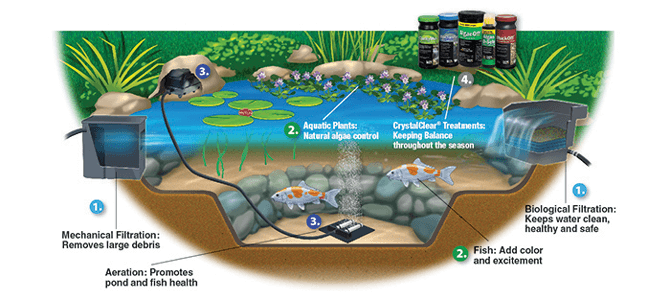
Water Gardens 101

Four Fundamentals of a Balanced Pond:

As much as we would like to say a balanced water garden just happens, it doesn’t. To achieve crystal clear water and to keep fish and plants thriving, you must understand the four fundamentals of a balanced pond: Aeration, Filtration, Plants and Fish, and Treatments.
-
Filtration: Keeps water clean, clear and safe.
Filtration is essential when building a pond. Without it, your pond can become a toxic place for fish and overrun with algae blooms. There are two types of filtration to be aware of: Mechanical and Biological.
Mechanical filters, like a skimmer, remove leaves and other debris that fall into the pond. Biological filters main job is to help jump-start the nitrogen cycle to break down toxic ammonia from fish waste and other decaying matter to nature's more useful form, nitrates.
-
Plants & Fish: Plants are natural filters, while fish add color and excitement.
Aquatic Plants are a fundamental part of a pond’s ecosystem because they feed off nutrients in the water column which serves as a dual purpose in a pond ecosystem. The nutrients they remove keep plants lush while at the same time the removal of those nutrients assists in cleaning pond water on a microscopic level.
Cover approximately 60% of your pond with a variety of aquatic plants. Fish, such as koi and goldfish, can add color and excitement to any pond, however, too many can cause water quality issues. We recommend 1 to 2 koi or 2 to 3 goldfish per 200 gallons of water.
-
Aeration: Promotes pond clarity and fish well being.
Waterfalls and fountain features alone can’t produce enough oxygen to maintain a balanced pond, but adding aeration kits such as a PondAir and KoiAir can. This type of aeration works from the bottom up by a process called “diffused aeration”. Diffused aeration is the air that is forced through a diffuser (chamber) by a small compressor. The diffuser then releases micro-bubbles through tiny perforations in the diffuser.
The diffuser sits at the bottom of the pond where it aerates the entire water column from the bottom up which greatly increases dissolved oxygen levels throughout the pond. Increased oxygen levels equal to disease-free fish and cleaner water. Aeration kits are also great for freezing climates where overwintering fish is a concern.
-
Treatments: Keep your pond balanced throughout the seasons.
Filtration, plants, fish, and aeration help create a balanced ecosystem initially but over time even the most well-maintained pond can become overrun from falling leaves, debris, fish waste, rainfall run-off, phosphates or pH fluctuations.
Over time, these influxes can cause algae, murky water, and other water quality issues. Water treatments help keep ponds from straying out of balance by breaking down waste, removing excess nutrients and maintaining clear water.
